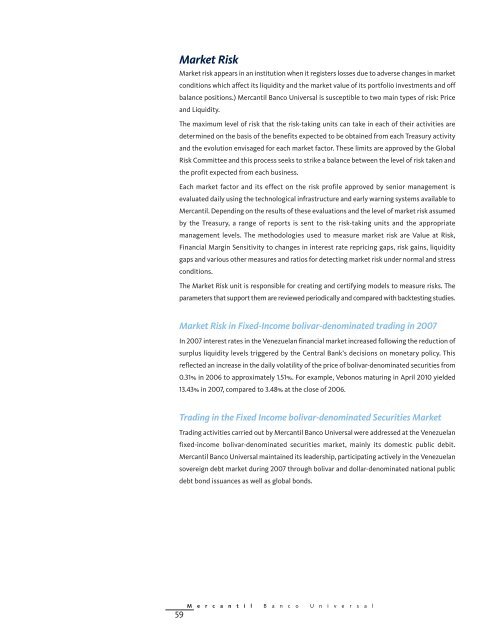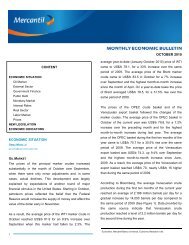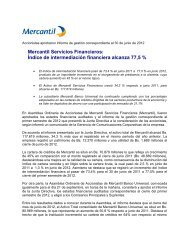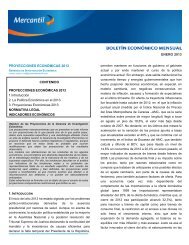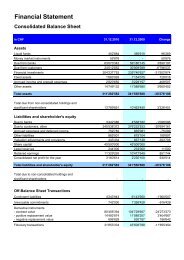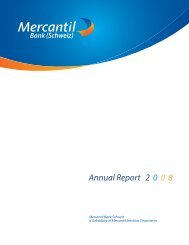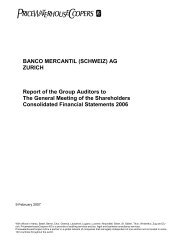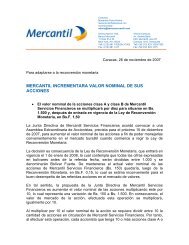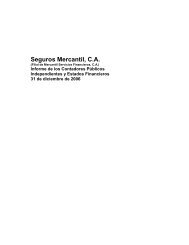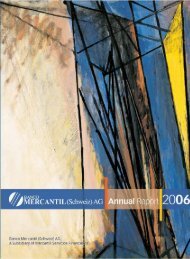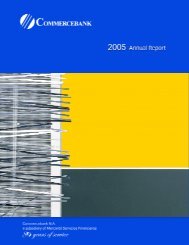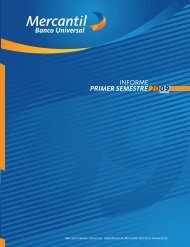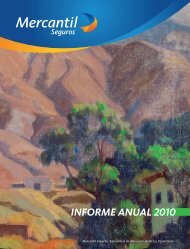Untitled - Banco Mercantil
Untitled - Banco Mercantil
Untitled - Banco Mercantil
Create successful ePaper yourself
Turn your PDF publications into a flip-book with our unique Google optimized e-Paper software.
Market Risk<br />
Market risk appears in an institution when it registers losses due to adverse changes in market<br />
conditions which affect its liquidity and the market value of its portfolio investments and off<br />
balance positions.) <strong>Mercantil</strong> <strong>Banco</strong> Universal is susceptible to two main types of risk: Price<br />
and Liquidity.<br />
The maximum level of risk that the risk-taking units can take in each of their activities are<br />
determined on the basis of the benefits expected to be obtained from each Treasury activity<br />
and the evolution envisaged for each market factor. These limits are approved by the Global<br />
Risk Committee and this process seeks to strike a balance between the level of risk taken and<br />
the profit expected from each business.<br />
Each market factor and its effect on the risk profile approved by senior management is<br />
evaluated daily using the technological infrastructure and early warning systems available to<br />
<strong>Mercantil</strong>. Depending on the results of these evaluations and the level of market risk assumed<br />
by the Treasury, a range of reports is sent to the risk-taking units and the appropriate<br />
management levels. The methodologies used to measure market risk are Value at Risk,<br />
Financial Margin Sensitivity to changes in interest rate repricing gaps, risk gains, liquidity<br />
gaps and various other measures and ratios for detecting market risk under normal and stress<br />
conditions.<br />
The Market Risk unit is responsible for creating and certifying models to measure risks. The<br />
parameters that support them are reviewed periodically and compared with backtesting studies.<br />
Market Risk in Fixed-Income bolivar-denominated trading in 2007<br />
In 2007 interest rates in the Venezuelan financial market increased following the reduction of<br />
surplus liquidity levels triggered by the Central Bank’s decisions on monetary policy. This<br />
reflected an increase in the daily volatility of the price of bolivar-denominated securities from<br />
0.31% in 2006 to approximately 1.51%. For example, Vebonos maturing in April 2010 yielded<br />
13.43% in 2007, compared to 3.48% at the close of 2006.<br />
Trading in the Fixed Income bolivar-denominated Securities Market<br />
Trading activities carried out by <strong>Mercantil</strong> <strong>Banco</strong> Universal were addressed at the Venezuelan<br />
fixed-income bolivar-denominated securities market, mainly its domestic public debit.<br />
<strong>Mercantil</strong> <strong>Banco</strong> Universal maintained its leadership, participating actively in the Venezuelan<br />
sovereign debt market during 2007 through bolivar and dollar-denominated national public<br />
debt bond issuances as well as global bonds.<br />
M e r c a n t i l B a n c o U n i v e r s a l<br />
59


